Top 10 tools every willow weaver needs
11 November 2025
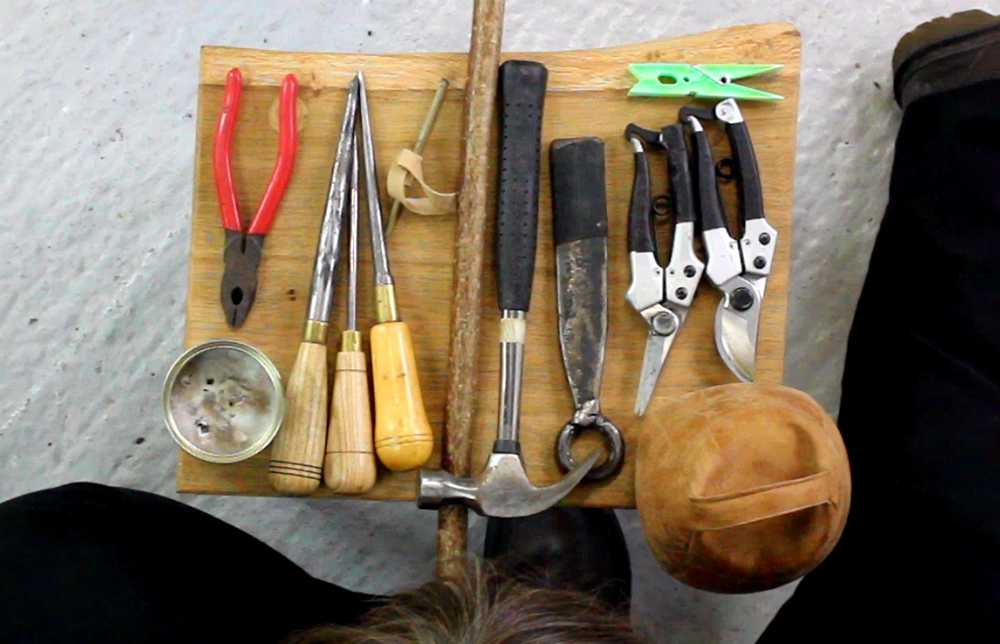
Willow weaving is a rewarding pastime that takes focus, patience, and persistence. Investing in good quality willow weaving tools makes weaving easier and more enjoyable.
At Musgrove Willows, the experience of our in-house team of basket makers and basketry and sculpture tutors grants us the ability to supply only premium willow weaving tools. We’ve worked with celebrated master toolmaker Dave Budd to develop our own range of exclusive products, designed to support anyone on their willow weaving journey.
Our top 10 essential willow weaving tools
We’re often asked what basket weaving tools weavers at the start of their willow weaving journey should buy. So, we’ve put together a handy guide to our top 10 willow weaving tools – and a list of 10 extra tools suitable for those developing their range of basketry tools.
1. Secateurs
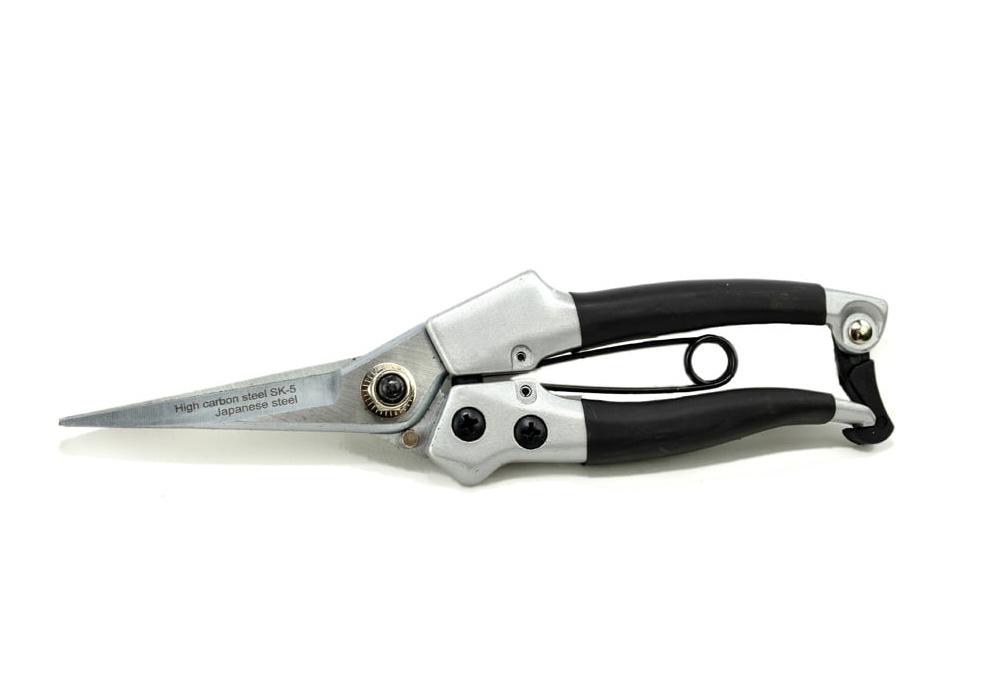
Secateurs come in two types: bypass and straight nosed. They are slightly different:
- Bypass secateurs – also known as parrot-beaked – are for normal working.
- Straight nosed secateurs – also known as snipe nosed – cut finer and are used for trimming off.
It’s important to keep your secateurs sharp, clean, and dedicated only for weaving purposes. They should never be used to cut wire.
2. Bodkin

When working on a willow weaving project, use the size of bodkin that matches the thickness of the willow you are using and the task you are doing.
For example, if you are opening up a base stick to create a slath using the butt end of a 6ft willow rod, you might want a 12mm bodkin. Any thicker and you will create too large a space.
If you are threading the border on the same basket, you may need to use a smaller bodkin – a 6 or 8mm bodkin – as the rod has tapered to the tip. Again, you only need the hole to be slightly bigger than the rod being threaded.
3. Rapping iron

A rapping iron is used to ‘rap’ (not whack) your weaving down as you weave and build up layers of weaving. It consolidates the weave through compression, allowing the weaver to not only level up their work but also create a tight basket with no gaps.
Rapping irons are sold in two different weights. You should choose the weight according to the willow you are using and the project:
- Most weavers and basket makers use a 500g rapping iron.
- A 1kg rapping iron is used for large-scale baskets, fencing, and similar applications.
Covering the end of your rapping iron with a short section of bike inner tube prevents the metal from marking the willow (particularly with bark-off willows) – but remember to remove it to let your rapping iron dry at the end of a weaving session.
The ring on top, contrary to popular belief, is not meant for hanging it up; you actually get two tools in one. The ring, also known as a commander, is used for straightening thicker sticks, like those used as end posts for square work.
You can also purchase commanders as standalone tools for larger projects. Over time, various styles have developed, but we prefer and sell the F-shaped version.
4. A heavy-duty 1000-gauge soaking bag

A good entry point for soaking is a soaking bag which, with careful use, can be reused time and again. Soaking bags are all 2m long and available in three different widths:
- 6” wide/2m long – can take 250g (equal to a small handful) of up to 5ft willow.
- 10” wide/2m long – can take 2kg of up to 5ft willow, or 4kg of up to 7ft willow.
- 12” wide/2m long – can take 4kg of up to 5ft willow, or 6kg of up to 7ft willow.
See our handy guide on how to use a soaking bag for more top tips. Many weavers, as their passion for willow weaving develops, move on from soaking bags and purchase a cattle trough (or similar) for soaking purposes.
5. Steaming sheets

Exclusive to Musgrove Willows, we also stock steaming sheets, which can be used alongside a wallpaper stripper (not supplied) to steam brown (bark-on) willow.
Steaming sheets can withstand the high temperatures steaming creates, allowing the willow to mellow after steaming. They enable the maker to achieve ‘weave-ready’ willow – especially in winter when the willow is one or two days short of a full soak. It also slightly darkens the willow, offering another colour option.
Our steaming sheets are available in two lengths and come with two adjustable straps and a how-to-use guide:
- Small (1.5m x 2m) – suitable for up to 5ft willow.
- Large (1.5m x 3m) – suitable for up to 8 ft willow.
Important: The willow needs to have had at least three-quarters of its normal soaking time before steaming.
6. Hessian sheet
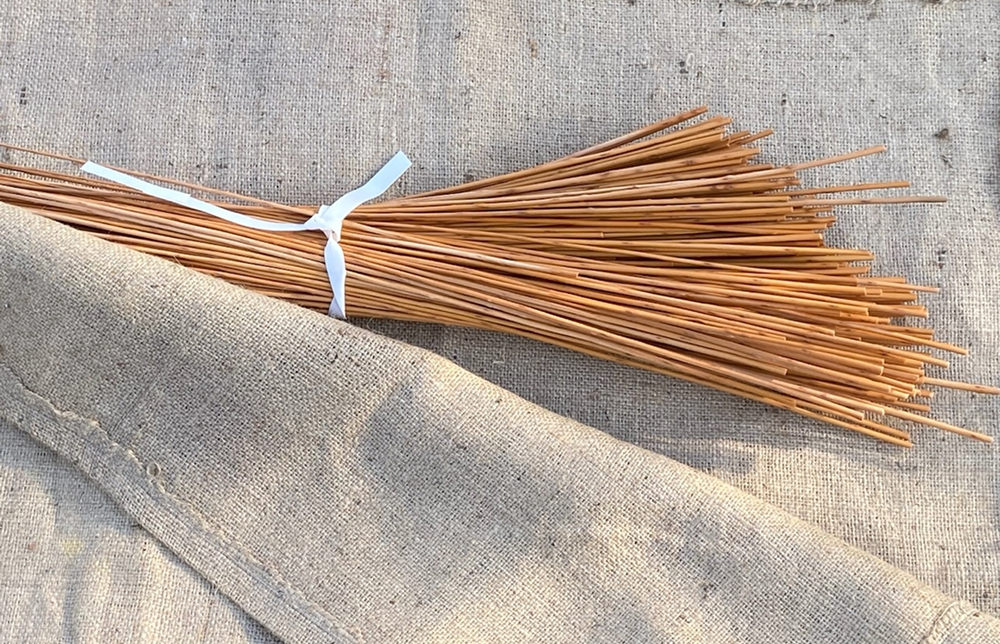
A hessian sheet can be used to mellow willow after it has been soaked. Hessian is ideal for this as it retains moisture while letting the willow breathe. Mellowing is an essential process as it helps willow to become supple.
Our hessian mellowing sheets are available in two lengths:
- 1m – suitable for wrapping willow up to 3ft in length.
- 2m – suitable for wrapping willow up to 8ft in length.
7. Basketmaker’s tallow substitute (vegan or vegetarian)
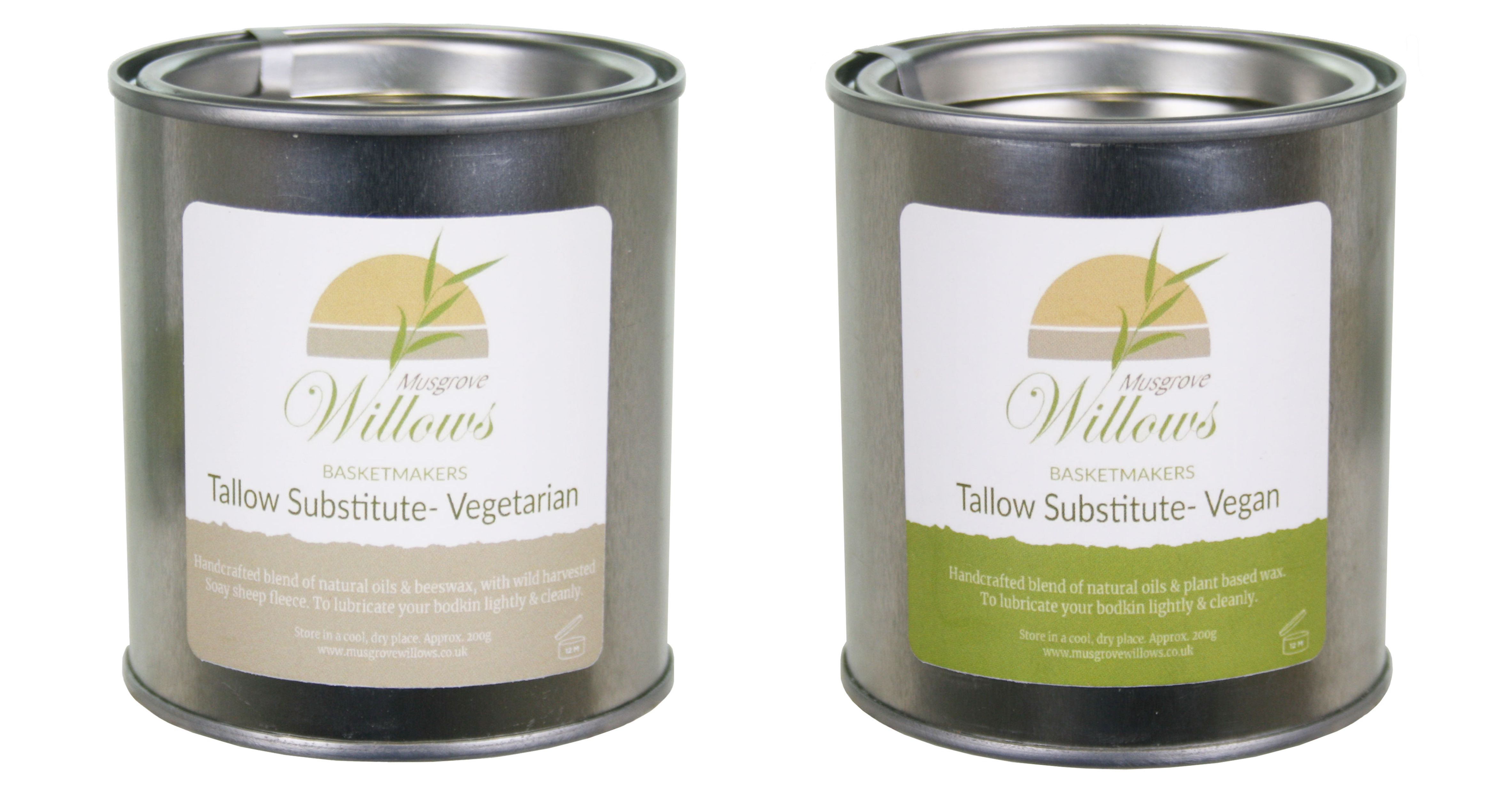
Tallow acts as a lubricant for your bodkin, and can also be used to aid the insertion of rods into tight spaces. We offer two exclusive tallow substitutes, handcrafted in small batches using responsibly sourced ingredients, and developed to offer an alternative to using animal tallow.
- Vegetarian tallow: Made using a blend of oils and waxes and non-shorn sheep fleece (which cleans a bodkin of excess lubricant).
- Vegan tallow: Made using plant-based waxes and without sheep fleece.
Check out our video guide on how to use our vegetarian and vegan tallow substitutes.
8. Spray bottle
Ideally, you should get a pressure sprayer. A spray bottle is essential for working with bark-off willow (buff, buff noir, or white) to ensure that the rod is kept workable.
9. Knife
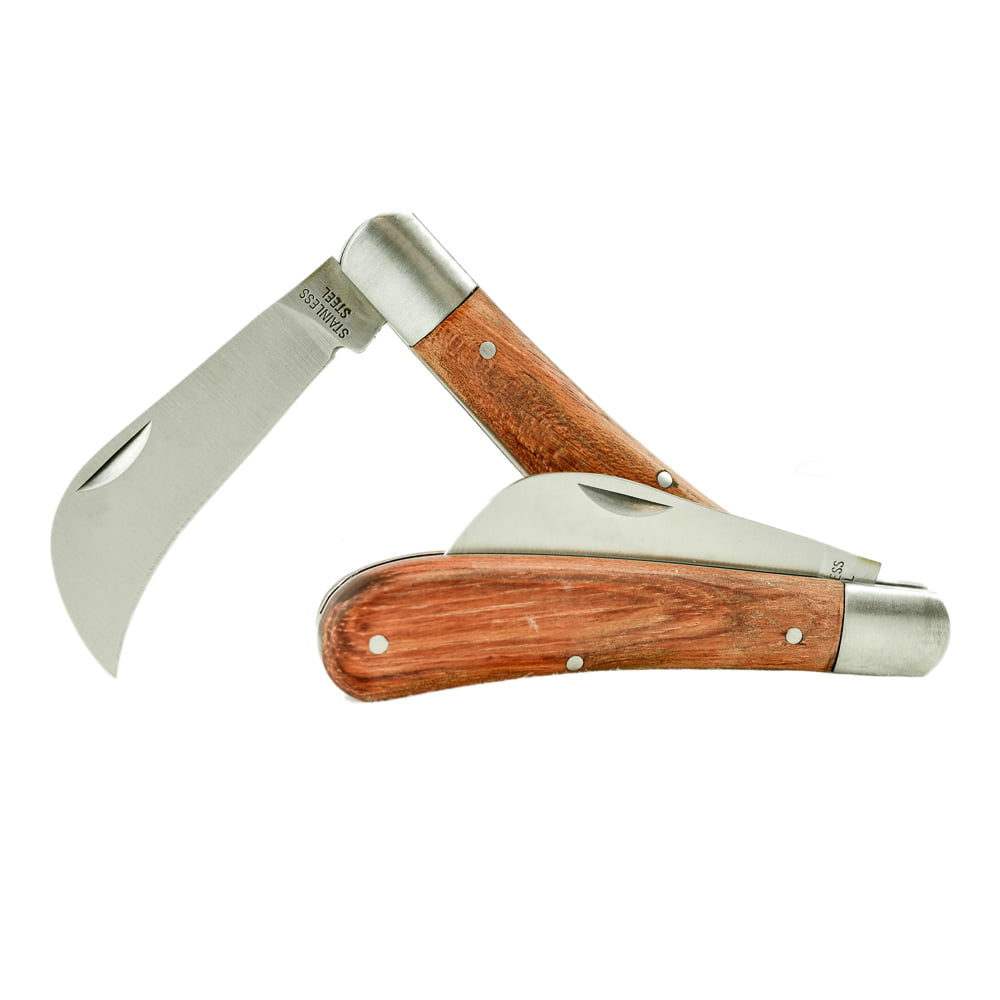
A knife is something unique to a maker. Everyone ends up with one they prefer, but a good entry-level knife is a folding shop knife. This knife can be used to do a range of tasks, and the curved blade makes it particularly good for cutting slypes.
10. Weight
When basketmaking, the base of the basket often needs to be weighed down as you work.
Your weight needs to be the right size to fit into your basket and not interfere with your weaving. For most baskets, this weight should be around that of a house brick. Stones, large pebbles, bricks, or iron weights (Victorian irons, cooking weights, etc.) are ideal.
If your weight has sharp edges or may scuff the basket, cushion it by wrapping it in bubble wrap (or a similar material).
If you’re using an iron weight, remember to ensure the metal does not come into contact with the willow, as it can mark it – just like your rapping iron, ensure it is dried after use. Some cork tile glued to the base of an iron weight is a good solution.
10 extra tools for developing basketry skills
- Hammer: A general, all-purpose hammer is perfect.
- Good quality saw: A second fix panel saw, a junior hacksaw with a wood blade, or a tenon saw for cutting larger rods/hazel handles.
- Cleave: Depending on the number of splits you require use a 3-way cleave or 4-way cleave and brass or wooden tips. Brass tips last longer and are more suited to heavier work. Cleaves should be used in conjunction with a shave and skeining tool.
- Screw block: Used for square work.
- Tape measure or rule: For measuring heights and widths.
- Sharpening equipment: For keeping all your tools in a sharp condition ready for use.
- Willow winder: Used for breaking the back of the willow when weaving round tight corners, or in more fluid, random weave baskets and sculptures. Most weavers use a rolling pin or similar.
- Side cutters: For finer cutting of material when trimming off.
- Loppers: For cutting larger material, or for working on living willow structures and sculptures.
- Drill and bit: For making holes in hazel handles, creating pilot holes for pins, etc.
For even more information on basketry tools, take a look at our Essential Tools for Basketmaking video, part of the collection of videos on How to Make a Basic Basket.







